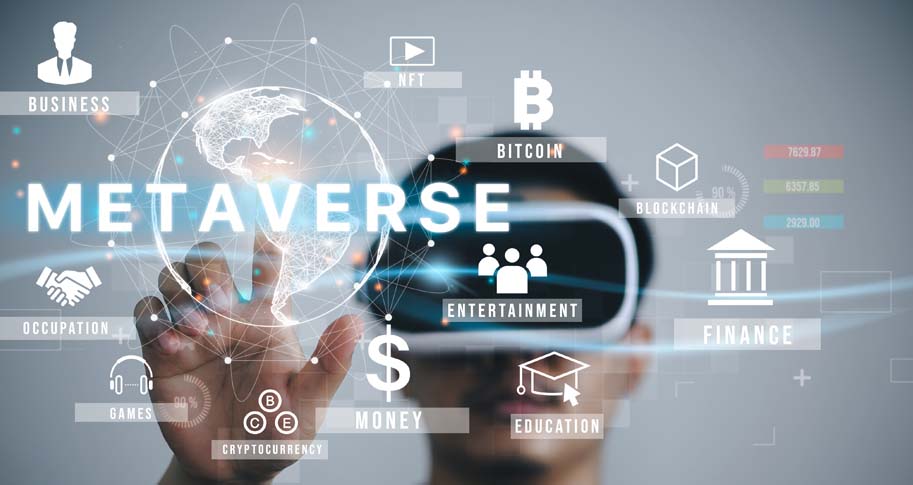
In October 2022, Apple CEO Tim Cook commented to Dutch magazine Bright that “I’m really not sure the average person can tell you what the metaverse is.” Most of the media attention at the time saw this comment as demonstrating Cook’s preference for augmented reality technology and product offerings or as a not-so-subtle dig at Meta. Other outlets saw this comment as a chance to define the metaverse as being “a catch-all term that describes what the internet will evolve to next” or to reprise Matthew Ball’s notion of the metaverse as being “a quasi-successor state to the mobile internet...[that will] build upon and iteratively transform it.”
But perhaps “what is the metaverse” is the wrong question. The better question is “what do we want the metaverse to be” - and that is the question that Mary Lacity, Jeffrey Mullins, and Le Kuai address in their whitepaper, “What type of metaverse will we create?”
We are playing the wrong word game; it’s not just about definitions, it’s about filling in the blanks. Instead of playing Balderdash, we should be playing Mad Libs.
After all, asking “what the metaverse is” assumes that it's a completed project or that it’s reached a stage of maturity where there are common attributes, best practices, and key metrics around it. Asking “what do we want the metaverse to be,” though, understands that the metaverse is a work in progress. We are largely living in a Web 2.0 world whereas the metaverse denotes Web 3.0. What the metaverse will become depends on the actions, choices, and purchase decisions we make now and in the near future.
Although the metaverse’s definition and future remain undetermined, significant economic opportunities exist even if a single, well-defined metaverse is more than a decade away. This opportunity can be seen in the race to stake claims in the proto-metaverses that exist currently, as companies feel they cannot afford to wait until the metaverse fully evolves to experiment and invest in it. Should these proto-metaverses continue to develop and shift into a single, interoperable metaverse, Lacity, Mullins, and Kuai argue that we all should consider what benefits we hope to gain from a metaverse, what risks should be avoided, and what controls and governance procedures should exist.
What can the metaverse do for you?
Even though there’s no set definition for what a metaverse is, a common vision is emerging out of the many proto-metaverses that currently exist. The metaverse is often thought to be, as Matthew Ball argues, “a quasi-successor state of the mobile internet” that will have the following qualities:
Attribute |
Description |
| Real-time rendered | The process of generating images in real time. Currently, virtual worlds are pre-rendered, with options pre-selected. Real-time rendering would allow infinite possibilities for user choice and interaction, but requires an exponential jump in computational power. |
| 3D | The realistic perception of three-dimensional (length, width, depth) space, rather than the traditional rendering of virtual environments in two dimensions (e.g., computer monitors, phone screens). |
| Virtual worlds | Computer-generated environments that are recognizable to their inhabitants and distinct from one another. |
| Synchronous for an unlimited number of users | The internet works by sending asynchronous feeds; at sufficiently high speed, we experience interactions as synchronous (e.g., video conference); the metaverse will need to do this at much greater scale. As Ball notes, Fortnight’s Travis Scott concert in 2020 was rendered across 250,000 copies—it was not truly synchronous for the 12.5 million attendees. |
| Persistent | The idea that objects and environments endure—their states are maintained, and their history is preserved, in the metaverse. By contrast, VR games are reset, as avatars die and come back to life; video calls end, and the virtual “room” disappears after everyone disconnects. A persistent metaverse would preserve the states of events and objects irrespective of any given user’s participation in the environment. |
| Sense of presence | Three-dimensional spaces create immersive user experiences via depth perception (vision), sound localization (hearing), touch, smell, and/or taste perception. |
| Interoperable network | Today, virtual worlds operate as islands. There are currently no standards for metaverse interoperability. |
A single metaverse contains the potential to “disrupt and reshape the business, social, educational, political, and economic landscape of our world," much like the seismic internet developments that preceded it. A metaverse is, at a minimum, a virtual world. The metaverse could engender an explosion of inclusivity, with millions of users gaining access to work, education, healthcare, events, ideas, and places they’d hitherto been excluded from. New jobs could emerge – from virtual teachers and real estate agents to fields we cannot even envision yet – and new opportunities for mobility and sensation for physically disabled users.
These gains for inclusivity and innovation largely revolve around the fact that a metaverse, at a minimum, is a virtual world we visit with an avatar. In the Zoom and Teams calls we’ve all grown accustomed to – and exhausted by, we appear as ourselves in a videoconference room that then ceases to exist the moment we exit that room. In the metaverse, we will appear as avatars, and that virtual world will continue to exist even after we exit it.
Emergent interface technology will also play a role in making these inclusive and innovative futures a reality. Yes, VR headsets are often seen as the technology for the metaverse, but wearable technology can go far beyond headsets. For example, haptic hardware – from gloves, vests, and full body suits – can provide a sense of touch by applying vibrations or touches. Olfactory headset attachments, which emit bursts of scent from VR headsets, are beginning to come to market, and gustatory devices that simulate taste, while not commercially available, are in the R&D phase. As the market matures and these products improve, users may eventually access the metaverse via microchip body implants.
While these technologies may look clunky today and seem reminiscent of an underfunded science-fiction movie, think of how much your laptop weighed a decade ago compared to how much it weighs now, or how much more computing power your phone has now compared to a decade ago? The user experience, processing power, and portability of these products, given the right tailwinds, will improve.
Already, augmented reality (AR) - which is included as a key feature of the metaverse by many stakeholders – is being used in businesses for training and maintenance. AR overlays digital content on physical surroundings, thus allowing AR users to be present simultaneously in virtual and physical environments. AR has clearly come a long way since Pokémon Go and is expected to affect industries as diverse as construction, design, manufacturing, professional services, retail, and transportation.
This potentially more inclusive, innovative future does not depend solely on technological developments but also on governance. In our Web 2.0 world, our experiences online are mediated by companies that control users’ identities online, centrally managed and controlled digital assets, and a lack of interoperability – we cannot even make iMessage talk to Android seamlessly, much less have control of our credentials and digital identities so we can move them from platform to platform. Web 3.0 will likely reach its full potential if it relies on a decentralized digital infrastructure rather than a handful of major players controlling access and resources.
What can the metaverse do to you?
All this wearable tech and all these interactions your avatar makes will create voluminous amounts of data. Furthermore, concerns exist that the metaverse will simply reinscribe the same issues of addiction, cyberbullying, depersonalization, security breaches, and surveillance. As before, the choices we make now and over the next few years will determine what behaviors become normative in the metaverse.
As vibrant a future as wearable technology and implants could create, the potential equally exists that these devices create yet another barrier to entry for users. It is not hard to imagine the digital divide widening because of the metaverse, especially if there’s no “equal access to appropriate technology, networks, and training.” If users now do not insist upon more control over their digital identities and information, then we may see the metaverse to come being governed along similar, less-than-user-friendly Web 2.0 lines that limit options rather than give users authority.
Beyond these worries about equity and access looms the threat of disinformation, misinformation, and manipulation. Even if the metaverse coalesces around “free” services offered by providers, the question remains to what end these providers will use and monetize the data users give in exchange for access. If you thought Cambridge Analytica’s influence was noteworthy – which was based largely on what people willingly, if not thoughtlessly, disclosed on social media – then the “potential for manipulating attitudes and behaviors in a metaverse is terrifying.” The voluminous amounts of biometric data you produce would be owned by someone else. Instead of you having to signal what you like via a heart icon or your time spent on a page or feed, providers could simply track your eye movements, heart rate, posture, neural impulses, and so forth. Instead of you actively disclosing information, every second of every moment you are on the platform could be harvested and monetized.
Likewise, when Meta misuses your data, you can sue Meta – and perhaps win. If the metaverse does indeed manifest in a more decentralized environment than our current iteration of the internet, manifesting as an environment where no one node on the network has central authority, then who is the responsible party when ethical or legal concerns arise? Decentralized architectures do indeed show more resilience when it comes to cybersecurity “because the attack surface is diffused across many locations” but it also lacks the clear control and accountability as well as swift decision-making capability of a more centralized network. To what extent are users willing to pay the higher costs of decentralization in return for more control over their own information remains a question that metaverse users and interested parties will have to answer eventually.
That question of information control and decentralization leads to the larger question of governance. What sort of metaverse do we want inevitably leads to what sort of controls can we live with? If the metaverse that arises resembles our current internet in terms of governance and controls, then we can expect more surveillance and ever less control of the biometric information and data we produce.
Do we want the internet to continue to evolve – as it has gradually over the past 15 years – and give power and control to users? Or do we privilege accountability, efficiency, and lower duplication of efforts in the metaverse? Currently, proto-metaverses, such as Roblox, Second Life, and Fortnite, among others, are owned and controlled by institutions. But centralized, institutional control is not the only option available for proto-metaverses or the interoperable metaverse to come.
How can the metaverse mature?
A metaverse that reaches its potential and does more things for citizens and consumers than it does things to them is possible. But those blanks won’t fill themselves in – we all, as users, must advocate for a metaverse that meets our needs. Lacity, Mullins, and Kuai advocate that the way to reach that inclusive and innovative potential is via decentralized community control. Control and voting rights would be distributed throughout the network rather than concentrated in the hands of a few institutions or companies. The foundations for this sort of governance already exist both in fact and in theory – smart contracts, governance tokens, self-sovereign identity – but what does not exist (yet) is a groundswell of user sentiment advocating for this model.
Granted, this decentralized metaverse may not operate at first with the speed, accountability, and efficiency of a private or centrally controlled one. But what it will create is a host of new, necessary possibilities: more individuals owning and monetizing their identities, credentials, data, and digital assets, freely coming and going across interoperable virtual worlds, lower transaction fees and more secure transactions, and inclusive and equitable access to the metaverse. The real work now, the authors contend, is creating the standards needed for Web 3 as well as effective business models to “incentivize Web 3 innovation and adoption.” Those standards will go a long way towards making sure more voices get to be heard and that more people can get in – and stay in – the game.







